0091 If archeomodernity serves as a receptor for a productive matrix in the West, then why does Dugin want to get rid of it as his first task.
Remember that his task is to envision the possibility of a Russian philosophy.
So, Russia is not the same as western Europe.
0092 Consequently, the archeomodern groove must be different. In the west, Anselm’s slogan pairs with Descartes’ slogan to form the sides of a receptor. In Russian, a slogan from the premodern past pairs with, perhaps, a Marxist slogan, to form two sides of a trap.
In western Europe, the archeomodern groove tends to bind to nested forms that are not purely empirio-schematic judgments, which pisses off the scientific experts to no end (and explains the persistence of phenomenology and similar research programs).
In Russia, the archeomodern groove may bind to bad ideas, giving them an authority that they would otherwise not enjoy.
0093 Well, what would this Russian archeomodern groove look like?
Since I am not Russian, I cannot say. But, I can make suggestions based on what little I know about Russia, with the expectation that Russian philosophers will surpass my suggestions without looking back.
Here goes a fool’s attempt at the Russian archeomodern groove.
0094 Slogans are wonderful sources for nested forms. They are pithy. They readily separate out into normal context, actuality and potential.
0095 So, what about the archeo- side of the groove?
In the west, there is a slogan that calls to mind the world of Saint Basil and the Love of Sophia. It is an appeal to an archangel, Saint Michael, who fights Lucifer and casts him out of God’s realm. Yes, this is the stuff of Paradise Lost.
The slogan says, “Saint Michael, the archangel, defend us!”
The normal context is angels3. The potential is being defended (or defense)1. The actuality is us2 (in an unnerving situation).
Here is a picture.
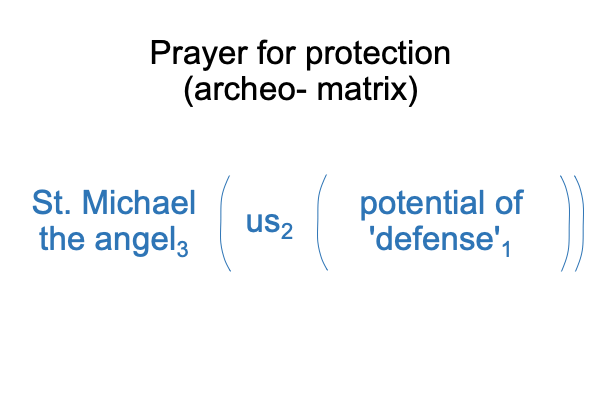
0096 What about the -modern side of the groove?
To me, one of the Marx’s most famous phrases is “the specter of communism”. The specter of communism haunts the mercantile society of Marx’s time. So, I will add a few words to turn the phrase into a slogan. The specter of communism haunts us.
Here is the corresponding nested form.
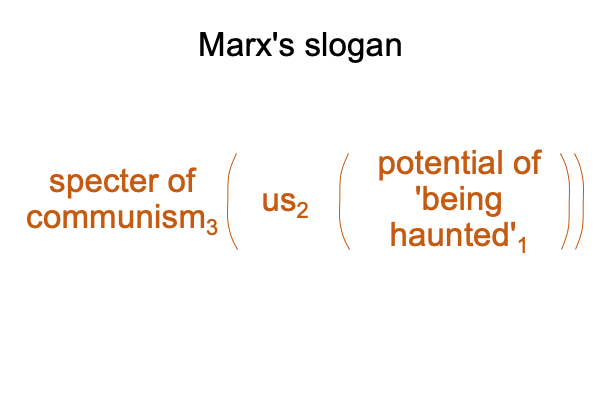
0097 Now, I combine these two nested forms into the structure of an archeomodern groove.
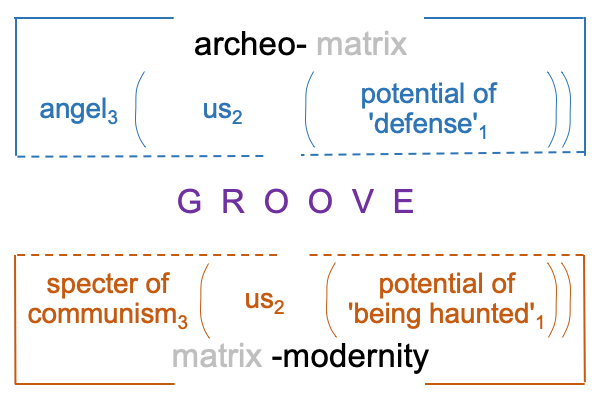
0098 What nested form fits into this groove?
The example that I choose belongs to the famous Stalin-era scientist, Lysenko. According to western sources, Lysenko ruined Soviet biology by promoting Lamarkianism, the idea that acquired traits may be inherited.
In particular, in agriculture, Lysenko wanted to plant wheat seed that had been frozen, because exposure to cold for the seed should produce the acquired trait for the plant. Of course, this does not work, since frozen grain will not germinate. Nevertheless, Lysenko did not fail for lack of trying.
0099 This example turns into a nested form through the following associations. The normal context is survival3, in the evolutionary sense of the term. The actuality is frozen wheat2. The potential is the acquired trait of cold resistance1.
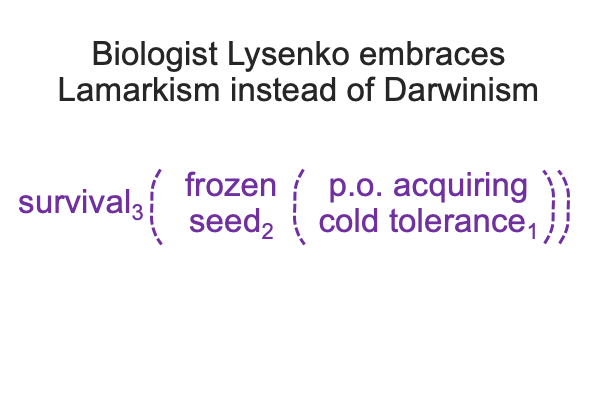
0100 Now, I place Lysenko story’s nested form into the groove and ask, “Can I envision how the nested form might fit (or bind to) each side of the groove?”
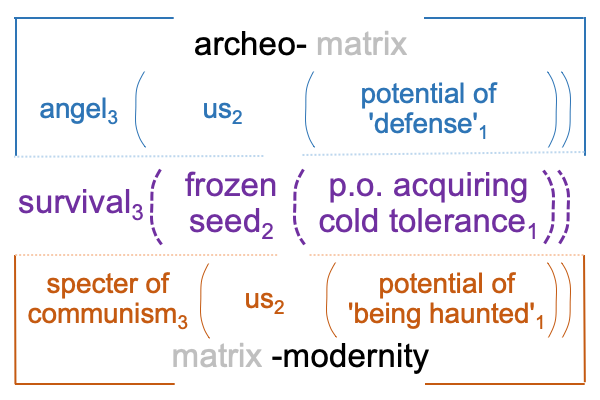
For the archeo- side, surely survival3 and angels3 attract one another. Otherwise, why would we ask Saint Michael to defend us?
For the -modern side, survival3 coheres with the soul of wheat seeds3. All wheat seeds should have the capacity to perpetuate acquired traits (even though, really, they do not). Once the seed is frozen, it is dead, and its soul becomes a specter. Perhaps, I can say, the seed becomes the specter of Lamarkianism.
Similarly, the acquired trait of cold tolerance1 should haunt1 the plant that grows from a frozen seed2. Plus, the anticipated acquired trait1 serves as a defense against cold weather1.
0101 Ah, Lysenko’s intuition binds well to the archeomodern groove for the Russian matrix.
The problem?
The fact that Lysenko’s Lamarkian proposition binds to the archeomodern groove for the Russian matrix does not make it correct. Indeed, the binding is so strong that experiments are conducted over and over again, with slight variations, but always with the same results. But, how can the experimental results turn out negative, when the proposition obviously fits our archeomodern groove?
Ah, now I can see how the archeomodern groove may be a trap.
0102 The concept of an archeomodern groove adds value to Dugin’s first task because it allows a way to envision how western European and Russian philosophies differ.
The Western archeomodern groove, composed of slogans by Anselm and Descartes, produces bindings that are so productive that western scientists want to dismiss the Western archeomodern groove. Why? People read popularized science in order to understand. Yes, people want to understand. People have faith, in God and in science. Why don’t common folk only care about drab scientific results? Why do they want to see how scientific models fit into a bigger picture?
Dugin wants to map the Russian archeomodern groove because it attracts and binds ideas that are satisfying, but scientifically impossible. The Russian archeomodern groove is a trap.
